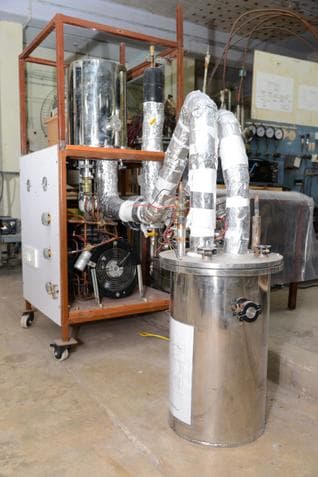IIT Madras Develops -200° C Refrigerator, Works 3 Months Non-Stop!
Engineers at Indian Institute Of Technology, Madras (Chennai) have developed a refrigerator that can achieve temperatures as low as -200 degree C, using a single stage vapour compression refrigerator that uses a compressor regularly used in domestic refrigerators and ACs. The working pressure of the compressor is also almost the same as that in Air Conditioners. Professor G. Venkatarathnam, Refrigeration and Airconditioning Laboratory at the Department Of Mechanical Engineering says that the system was operated non-stop at -200 degree C for three months non-stop.

Using the conventional cascade refrigeration system, temperatures as low as -110 degree C can be easily achieved. However, in the new system developed by engineers at IIT-Madras, three refrigerators were connected in a series and they worked in sync to bring down the temperature in steps. Professor Venkatarathnam explains that the main disadvantage of this technique to bring reduction in temperature is that each stage requires one compressor and a few heat exchangers. This makes the overall circuit complex and expensive as well.
Conventional refrigeration systems use a single liquid coolant that absorbs heat and becomes vapour at a constant temperature. The new technology developed at IIT uses a mixture of coolants where the conversion of liquid to vapour occurs over a range of temperatures, in an internal heat exchanger. The heat exchangers used by the team are capable of working at very large temperature difference of about 200 degree C, unlike the conventional systems in which heat exchangers work at one temperature. Prof. Venkatarathnam mentions that most of the applications won't need -196 degree C.
Talking about the applications of the new cooling system his team has developed, Prof. Venkatarathnam says that it can be used in food preservations, prevention of biological tissues, long-term blood preservation, semiconductor industry to improve vacuum levels and in cooling of electronics - especially in telescopes and infrared sensors.
Via: <a href="https://www.thehindu.com/sci-tech/technology/a-200-c-refrigerator-developed/article4974312.ece" target="_blank" rel="noopener noreferrer">A -200° C refrigerator developed - The Hindu</a>

Photo Credit: The Hindu
Using the conventional cascade refrigeration system, temperatures as low as -110 degree C can be easily achieved. However, in the new system developed by engineers at IIT-Madras, three refrigerators were connected in a series and they worked in sync to bring down the temperature in steps. Professor Venkatarathnam explains that the main disadvantage of this technique to bring reduction in temperature is that each stage requires one compressor and a few heat exchangers. This makes the overall circuit complex and expensive as well.
Conventional refrigeration systems use a single liquid coolant that absorbs heat and becomes vapour at a constant temperature. The new technology developed at IIT uses a mixture of coolants where the conversion of liquid to vapour occurs over a range of temperatures, in an internal heat exchanger. The heat exchangers used by the team are capable of working at very large temperature difference of about 200 degree C, unlike the conventional systems in which heat exchangers work at one temperature. Prof. Venkatarathnam mentions that most of the applications won't need -196 degree C.
Talking about the applications of the new cooling system his team has developed, Prof. Venkatarathnam says that it can be used in food preservations, prevention of biological tissues, long-term blood preservation, semiconductor industry to improve vacuum levels and in cooling of electronics - especially in telescopes and infrared sensors.
Via: <a href="https://www.thehindu.com/sci-tech/technology/a-200-c-refrigerator-developed/article4974312.ece" target="_blank" rel="noopener noreferrer">A -200° C refrigerator developed - The Hindu</a>
0
